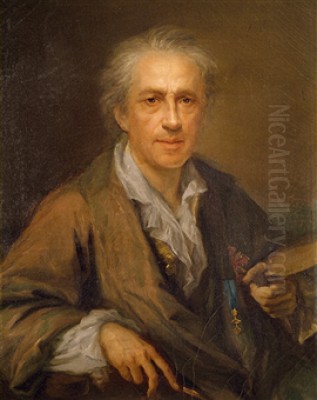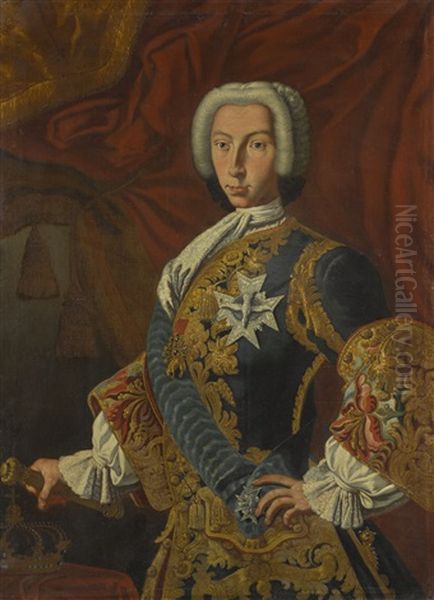
Giuseppe Bonito stands as a significant figure in the vibrant artistic landscape of 18th-century Naples. Born in Castellammare di Stabia, a town near Naples, in 1707, his life and career unfolded during a period of immense cultural flourishing in the city, then the capital of an independent kingdom under Bourbon rule. Bonito navigated the transition from the dramatic intensity of the late Baroque to the lighter elegance of the Rococo, becoming a favoured painter of the court and a leading figure in the Neapolitan art establishment before his death in Naples in 1789. His legacy is primarily built upon his skillful portraits and his engaging genre scenes, which offer vivid glimpses into the society of his time.
Early Life and the Shadow of Solimena
Bonito's artistic journey began in the bustling workshops of Naples, the most crucial step being his apprenticeship under the dominant figure of Neapolitan painting, Francesco Solimena (1657-1747). Solimena, often called 'L'Abate Ciccio', was a towering master whose dramatic compositions, rich colour, and dynamic use of light and shadow defined the late Baroque style in Naples and influenced artists far beyond the city. Entering Solimena's studio meant immersing oneself in this powerful artistic tradition.
The influence of Solimena is clearly discernible in Bonito's earlier works. He absorbed his master's command of complex compositions and his characteristic chiaroscuro, the dramatic interplay of light and dark. However, even as a pupil, Bonito began to hint at a distinct artistic personality, one perhaps less inclined towards the grand historical or mythological narratives favoured by Solimena and more drawn to the observation of human character and daily life. His training provided a formidable technical foundation upon which he would build his own successful career.
Emergence as an Independent Artist
By the 1730s, Giuseppe Bonito had established himself as an independent master in Naples. While the foundational influence of Francesco Solimena remained, Bonito started to cultivate a more personal style. This emerging style retained the robust painterly quality and compositional confidence learned from his master but gradually moved towards a slightly lighter palette and a greater interest in capturing textures and the nuances of expression, particularly in smaller-scale works.

His reputation grew steadily through commissions for local churches and private patrons. Naples, as a major European capital, offered ample opportunities. The city's numerous churches required altarpieces and decorative cycles, while the aristocracy and burgeoning middle class sought portraits and paintings to adorn their palazzi. Bonito proved adept at fulfilling these varied demands, demonstrating versatility that would serve him well throughout his career. He began to distinguish himself from other Solimena pupils, such as Francesco de Mura and Corrado Giaquinto, by developing his particular niche in portraiture and genre painting.
The Painter of Neapolitan Life: Genre Scenes
One of Bonito's most celebrated contributions is his work in genre painting. These scenes depict everyday life, often focusing on the activities, customs, and characters of Naples. He captured street musicians, market vendors, domestic interiors, school lessons, and popular entertainments with a keen eye for detail and a lively narrative sense. These works moved away from the heroic or divine subjects of much Baroque art, offering instead intimate and often charming vignettes of contemporary society.
His genre scenes are characterized by careful observation, animated figures, and a skillful rendering of fabrics, objects, and settings. Works like The Music Lesson or The Schoolmaster exemplify his ability to create engaging compositions filled with anecdotal detail. While sometimes idealized, these paintings provide invaluable visual documentation of 18th-century Neapolitan culture, capturing its energy and social fabric. His approach often incorporated a gentle humour and warmth, making the scenes accessible and appealing.
Comparison with Gaspare Traversi
When discussing Bonito's genre painting, it is essential to mention his contemporary, Gaspare Traversi (c. 1722-1770). Traversi was another Neapolitan painter specializing in genre scenes, and the works of the two artists have sometimes been confused by later historians. While both depicted everyday life, their approaches differed. Traversi's scenes often possess a sharper, more satirical edge, sometimes exploring the foibles and vices of society with a Caravaggesque realism and dramatic lighting, often focusing on middle-class or even lower-class interactions with a theatrical flair.
Bonito's genre works, while equally detailed, generally tend towards a more graceful, less overtly critical depiction of society. His figures are often more elegantly rendered, and his settings can reflect a more comfortable, sometimes even aristocratic, milieu, aligning with the Rococo sensibility for charm and refinement. Despite these differences, the parallel development of genre painting by Bonito and Traversi highlights a significant trend in Neapolitan art, reflecting a growing interest in contemporary life alongside traditional religious and historical themes. The attribution of certain genre paintings continues to be debated between these two important artists.
Portraiture and Royal Patronage

Bonito achieved significant success as a portrait painter, a field that brought him to the attention of the highest levels of Neapolitan society. His ability to capture a likeness while imbuing the sitter with an air of dignity and elegance made him highly sought after by the aristocracy and the royal court. His portraits typically feature rich attention to costume details, refined poses, and a clear, often flattering, rendering of the sitter's features.
His career reached its zenith in 1751 when he was appointed official Court Painter to King Charles III of Bourbon (who ruled Naples as Charles VII before becoming King of Spain). This prestigious position solidified his status as one of Naples' leading artists. One of his most famous works from this period is the Portrait of Maria Amalia of Saxony, the wife of Charles III. This portrait, housed in the Prado Museum in Madrid, showcases his skill in rendering luxurious fabrics and conveying royal presence with Rococo grace. He continued to serve the court under Charles's successor, Ferdinand IV.
Religious and Decorative Commissions
While renowned for portraits and genre scenes, Giuseppe Bonito also produced a significant body of religious work and participated in large-scale decorative projects. He painted altarpieces for various churches in Naples and the surrounding region, including an important late work, the Immaculate Conception (1789), created for the Palatine Chapel in the magnificent Royal Palace of Caserta, the Bourbons' answer to Versailles, designed by the architect Luigi Vanvitelli.
His religious paintings often reflect the stylistic evolution seen in his secular work. While earlier pieces might show stronger ties to Solimena's dramatic Baroque, his later religious compositions tend towards the lighter colours, softer modelling, and more graceful movement characteristic of the Rococo. He also contributed to the decoration of the Royal Palace of Portici between 1736 and 1742, working alongside other artists on fresco cycles, further demonstrating his versatility and integration into the major artistic projects patronized by the Bourbon monarchy. Artists like Fedele Fischetti, another Solimena follower, were also involved in such decorative schemes.
Official Roles and Influence: Academy and Tapestry
Bonito's importance extended beyond his own artistic production. His success and reputation led to significant administrative and teaching roles within the Neapolitan art world. In 1752, his standing was recognized with membership in the prestigious Accademia di San Luca in Rome, a major honour for any Italian artist. More significantly for Naples, in 1755 he was appointed Director of the Accademia di Belle Arti (Academy of Fine Arts) in Naples.
In the same year, he also became the director of the Arazzeria Reale, the Royal Tapestry Manufactory. This dual role placed him at the heart of artistic education and high-level craft production under royal patronage. As director, he oversaw the training of young artists and guided the design and execution of tapestries, often based on cartoons created by himself or other leading painters. These positions underscore his authority and influence, shaping the direction of Neapolitan art during the mid-18th century. His leadership helped maintain high standards and ensured the continuation of Naples' strong artistic traditions.
Artistic Context: Contemporaries and Influences
Giuseppe Bonito operated within a rich and competitive artistic environment. His primary influence remained Francesco Solimena, but he interacted with and was aware of many other artists. Francesco de Mura (1696-1782), another prominent pupil of Solimena, was a direct contemporary and sometimes rival, known for his elegant and highly finished religious and mythological paintings, often displaying an even lighter, more purely Rococo sensibility than Bonito. Corrado Giaquinto (1703-1766), though working extensively in Rome and Madrid, also emerged from Solimena's circle and developed a brilliant international Rococo style that had resonance in Naples.
The broader Italian scene included figures like Sebastiano Conca (1680-1764), a Neapolitan-born painter who became a leading figure in Rome, and Pompeo Batoni (1708-1787), the great Roman portraitist whose style influenced aristocratic portraiture across Europe. Visiting artists also left their mark; the Venetian Rococo painter Jacopo Amigoni (1682-1752) worked briefly in Naples, potentially contributing to the taste for lighter palettes. In sculpture, Giuseppe Sanmartino (1720-1793) was creating masterpieces like the Veiled Christ, showcasing the technical brilliance of Neapolitan artistry in other media. Towards the end of Bonito's life, the winds of Neoclassicism began to blow, represented by artists like Anton Raphael Mengs (1728-1779), who worked for the court in Naples and Madrid, and Angelica Kauffman (1741-1807), who visited the city, signalling a shift away from the Rococo aesthetic Bonito largely represented.
Later Years and Stylistic Evolution
In his later career, Bonito continued to be productive, adapting subtly to changing tastes while largely remaining true to the stylistic path he had forged. His work retained its characteristic blend of Solimena's solidity with Rococo elegance. The Immaculate Conception of 1789, painted in the last year of his life for the Royal Palace of Caserta, demonstrates his enduring skill. While showing the lighter palette and graceful composition associated with the Rococo, it still possesses a compositional confidence rooted in his Baroque training.
He witnessed the rise of Neoclassicism, a style promoted by theorists like Johann Joachim Winckelmann and exemplified by painters like Mengs. While Bonito did not fully embrace the severity and archaeological precision of the new style, some late works might show a slight simplification of form or a calmer mood, perhaps acknowledging the changing artistic climate. However, he remained fundamentally a master of the Neapolitan late Baroque and Rococo traditions until his death in Naples in 1789.
Legacy and Conclusion
Giuseppe Bonito was a central figure in 18th-century Neapolitan art. As a student of the great Solimena, he absorbed the power of the late Baroque but forged his own distinct path, excelling in portraiture and genre painting. His appointment as Court Painter and his directorship of the Academy of Fine Arts and the Royal Tapestry Manufactory attest to his high standing and influence within the artistic establishment of the Kingdom of Naples.
His portraits provide valuable records of the Bourbon monarchy and Neapolitan aristocracy, rendered with Rococo elegance and technical skill. His genre scenes offer captivating glimpses into the daily life and culture of Naples, characterized by lively detail and careful observation, standing alongside the work of Gaspare Traversi as crucial examples of this burgeoning interest in contemporary subjects. While perhaps overshadowed internationally by his master Solimena or by contemporaries who embraced a more purely Rococo or later Neoclassical style, Bonito's substantial body of work remains essential for understanding the richness and diversity of painting in Naples during a period of exceptional artistic vitality. He successfully navigated the stylistic currents of his time, leaving behind a legacy as a versatile, accomplished, and quintessentially Neapolitan master.